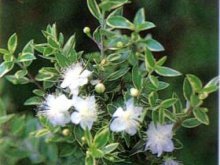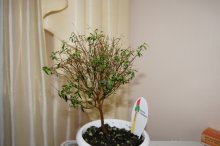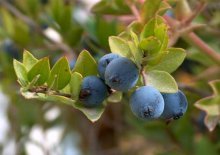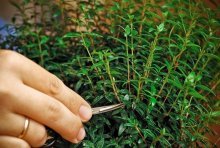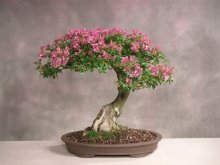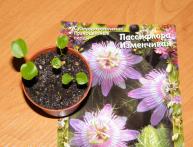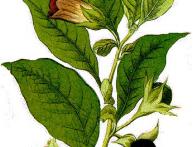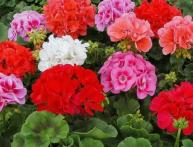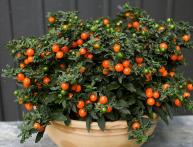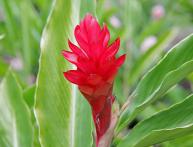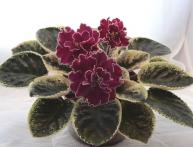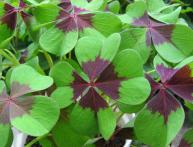Myrtle - flower, home care, features of planting and propagation
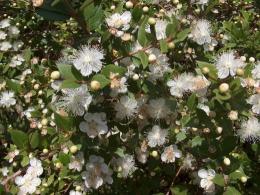
Myrtle - an evergreen shrub, which since ancient times has been considered throughout the world as a symbol of love, marriage and peace. It is valued by flower growers for its ease of cultivation and beautiful green head of small leaves.
Let's find out how to grow a myrtle flower at home and what care it will require.
Content:
- Brief description of the culture
- How to properly care for shrubs?
- Reproduction methods
- Features of agricultural technology in winter dormancy
- What are the benefits and harms of myrtle?
Brief description of the culture
Botanists have currently counted almost a hundred different species of this plant, growing in tropical conditions near the equator. And at home are grown As a rule, there are two types of myrtle: common myrtle and small-leaved myrtle.
In Mediterranean countries and the Middle East, this shrub has earned special respect and love; it has been cultivated for approximately 400 years. The first mentions date back to the times of Ancient Greece and Rome.
In ancient times, the area around the temples of Venus was planted with gardens of myrtle; at festivals in her honor, wreaths of twigs were placed on the heads of young men and women; and in Europe, brides’ outfits were decorated with it; it was considered a symbol of prosperity and happiness. During the Renaissance, the fragrant bush began to personify love and fidelity.

Many myths and legends are associated with this shrub.But myrtle was not so much a decoration and symbol for our predecessors; it was also valued for its healing and cosmetic properties.
How to properly care for shrubs?
Myrtle tree – flower with a dense crown, small dark green oblong shiny leaves and light flowers. The fruits are blue berries with seeds or nuts.
They are grown in greenhouses, apartments, private houses, winter gardens; flower care at home consists of the following factors.
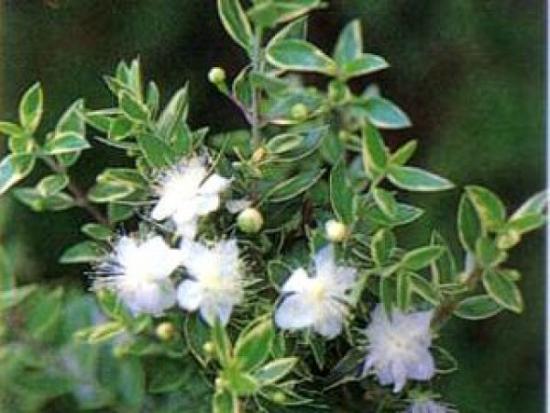
Temperature
The shrub is not capricious, and room temperature is perfect for it, the only difference from other pot dwellers is that it needs a cold wintering, approximately 8-10 degrees.
If you leave it in a room at a temperature of 20-23, you must constantly spray the crown. This way the flower will cope with the winter dry air.
Myrtle loves light, but not the scorching sun, so when placing it on a south window, it will be necessary to shade the bush at lunchtime. The northern window is a bad choice for growing; there will be practically no flowering, and the leaves will lose their brightness.
But drafts are not at all scary for a flower; you can take the plant outside balcony.
Watering
Watering is needed frequently, but there is no need to overfill. Stagnation of moisture or drying out should not be allowed. If drying out does occur, immerse the pot directly in water for 5-10 minutes. It is advisable to spray the crown daily, and even more often in winter. For watering and irrigation, use settled water, as the presence of lime in the water is detrimental to the plant.
The soil
The most favorable for growing is the soil, in which the flower grows in natural conditions: a mixture of turf, peat, coarse sand and humus.You can make the soil yourself, or buy a ready-made mixture for ornamental plants in the store.
No special feeding is needed; standard fertilizer for evergreens is sufficient, from March to August once every 1-2 weeks. The bush is not replanted often, once every 4 years, since the root system grows quite slowly, and young seedlings require replanting annually.
Trimming and pinching
How to conduct pruning and subsequent care for myrtle flowers at home? Bonsai lovers are very fond of this culture for its thick crown and small leaves. With patience and a little skill you can achieve the most bizarre shapes.
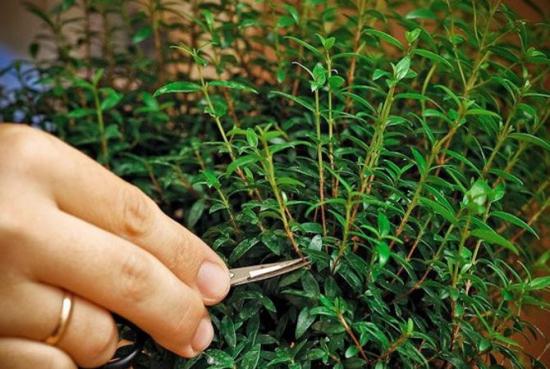
Pruning helps to form side shoots and add fullness. The plant is pruned in the spring, before active growth begins, and in the summer, the technique of pinching out young shoots is used.
Thanks to this pinching, the myrtle will bush well.
How to organize care for a myrtle flower at home to achieve good results flowering? If you want active flowering, it is better not to overdo pinching so that flower buds have time to form.
Features of agricultural technology in winter dormancy
The plant clearly observes a period of autumn-winter dormancy. It begins in mid-autumn and lasts until spring. At this time, the plant takes a break from active growing season and gains strength before future flowering.
Therefore, the conditions of care are slightly different from the rest of the period:
- The room temperature is reduced to 10 degrees.
- Reduce the number of waterings, but monitor soil moisture.
- Often sprayed if the flower is kept at room temperature.
Reproduction methods
The best method of reproduction is considered cuttings. This method preserves almost all maternal characteristics.When propagated by seeds, the characteristics deteriorate.
For propagation, cuttings of 5-7 cm are taken, in a semi-lignified form. The bush must be strong, healthy and free from pests. To obtain roots, it is best to use special compounds: kornevin and others.
The lower leaves are removed from the cuttings, the cut is treated with root growth stimulants, placed in peat for several centimeters and covered with a plastic bag or jar.
Move to a warm, bright place for 2-5 weeks. It is useful to ventilate the cuttings every few days to prevent the appearance of fungus or rot. The sprouted cutting is transplanted into a pot with soil and the top is pinched for the first time; without it, the myrtle will not begin to branch, but will grow into one trunk.
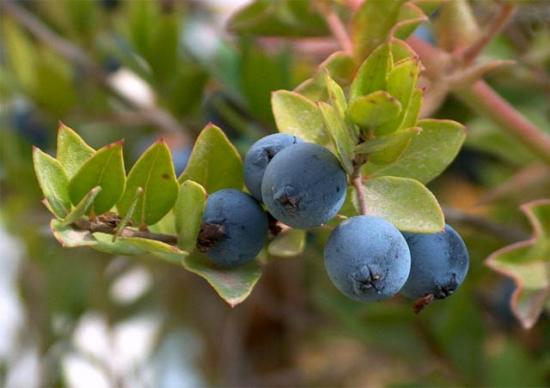
Propagation by seeds
For sowing seeds, you need to prepare a special soil: peat with sand in a 1:1 ratio. The soil is moistened or sprayed with fungicide. Seeds are sown on the surface and sprinkled evenly with a thin layer of soil.
Cover them in the same way as cuttings with a plastic bag or glass and place them in a warm place with a temperature of at least 20 degrees. Occasionally open for ventilation and moisture. The first shoots appear after 1-2 weeks.
Flower growers need to wait until the first two true leaves appear, after which they are cropped and transplanted into a separate pot using a transshipment method. Do not be alarmed by the slowdown in the growth of seedlings; it is normal for myrtle to freeze in growth after transplantation; soon your plants will actively begin to grow.
Myrtle usually blooms in the 3rd-5th year of its life, depending on the propagation method.
Diseases and pests that the plant encounters
With adequate adherence to agrotechnical technologies, the flower rarely gets sick and is little affected by pests.
The most common problem plant growers call is falling or drying of leaves. If they turn black, the reason lies in excessive, abundant watering. Loosening and less frequent watering, or transplanting into drier soil.
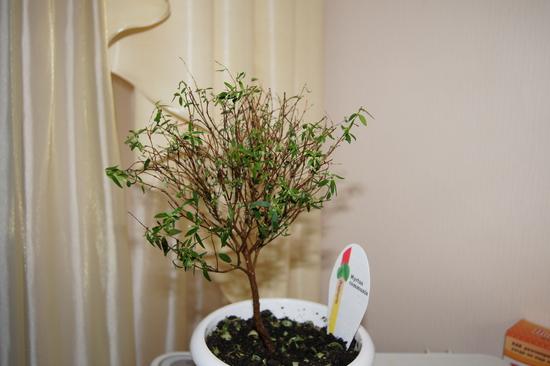
When the leaves turn yellow, on the contrary, you should water the plant more often and spray it. Move the plant a little further away from direct sunlight.
If your pet suddenly begins to lose leaves, think about the water you use for watering. Use only soft, settled water; it does not contain undesirable substances that adversely affect growth and flowering. Another factor for the appearance of shedding is banal overdrying.
In this situation, you can solve the problem by moving the pot to a cooler place. If the leaves begin to fall off immediately after purchase, then acclimatization is to blame.
In case of severe hypothermia, for example, if you left a flower near an open window in the frost, it will immediately react: all the leaves will dry out in a few days. You can help by cutting off dry leaves, spraying living branches with a biostimulant and covering them with polyethylene.
Among the pests found on myrtle are:
- aphid
- thrips
- scale insect
- spider mite
- mealybug
Aphids appear on the reverse side of leaves and live in entire colonies. The leaves wither and dry out. You can deal with them by spraying the branches and trunk with special preparations from flower shops. Before spraying, pests are removed under running water; when washing the flower, turn the crown down.
Shchitovka
The first sign of the appearance of this insect is a sticky coating on the bush. Shchitovka drinks juices from leaves, therefore it is as destructive as aphids. You can remove it by washing the leaves with a cloth soaked in a solution with soap, and after that you need to treat it with an insecticide.
Spider mites form cobwebs in the crown of myrtle; they are eliminated by spraying with tobacco tincture or with an insecticide.
The whitefly is like a small moth, it settles on the back side of the leaves and drinks the juice like an aphid. Whiteflies are difficult to remove because their larvae have a special coating that prevents drugs from penetrating and destroying them. Adult whiteflies are removed by hand, each leaf and stem is wiped with a soap solution, and then sprayed with Actellik. Up to 5 such treatments will be needed.
What are the benefits and harms of myrtle?
This plant is widely used in perfumery, cosmetology, and, of course, for medicinal purposes. A feature of the shrub is its pronounced aroma, alluring smell. Essential oils are concentrated in special dark bubbles on the back of the leaves.
The oil contains a large number of elements:
- Camphor
- Resins
- Tannins
- Camphein
- Amino acids
However, sensitive people should beware of myrtle, as it aroma oils may cause migraine attacks and nausea. Myrtle is especially valuable for the presence of properties similar in action to antibiotics, but without side effects in the form of dysbiosis in the body.
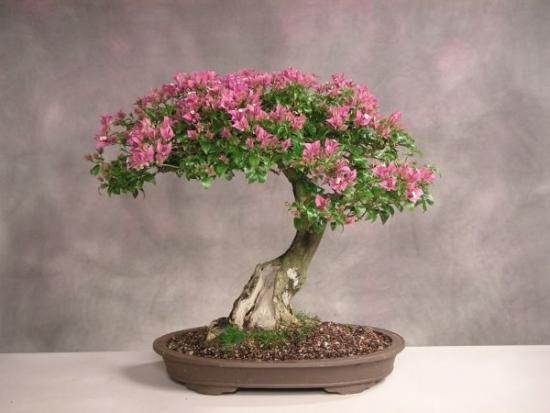
Therefore, it is often used for preventive purposes for:
- Pyelonephritis
- Herpes
- Tonsillitis
- Sinusitis
- Asthma
- Bronchitis
- Tuberculosis
- Diphtheria
- Some types of influenza
- Diseases of the gastrointestinal tract
- Ranah
- Suppuration
- Burns
- Scalp diseases
Various infusions, powders, ointments, and emulsions are made from the leaves.Even the flowers and fruits of the plant are used for medicinal purposes, and delicious healing wine is produced from them.
Myrtle is a real healer, it has the following properties:
- Bactericidal
- Expectorant
- Astringent
- Antiseptic
- Stimulates the brain
- Has a calming effect
- Is an immunomodulator
The unusual evergreen myrtle will appeal to all gardeners. With proper care and compliance with growing technology, it will delight you with a beautiful thick crown, abundant flowering and a pleasant aroma. Follow all the subtleties of care and care for the flower, and myrtle will become your favorite indoor inhabitant.
We hope that the information received from the article will be useful for you to get to know the flower more clearly myrtle and caring for it at home - watch the video:

